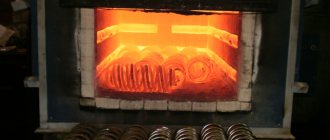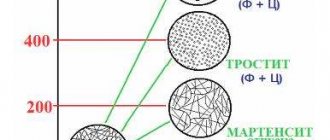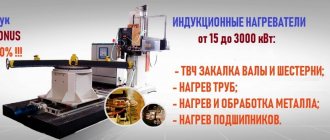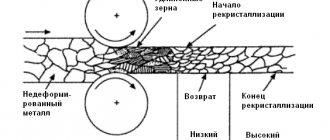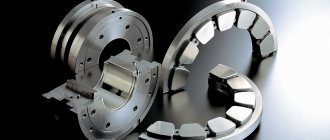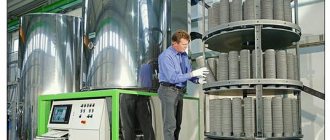In hydromechanical systems, devices and assemblies, parts that operate on friction, compression, and torsion are most often used. That is why the main requirement for them is sufficient hardness of their surface. To obtain the required characteristics of the part, the surface is hardened with high frequency current (HFC).
In the process of application, high-frequency hardening has shown itself to be an economical and highly effective method of heat treatment of the surface of metal parts, which gives additional wear resistance and high quality to the treated elements.
High frequency hardening technology
HDTV surface hardening is a heat treatment process to increase the strength characteristics and hardness of the workpiece.
The main stages of surface hardening of HDTV are induction heating to a high temperature, holding at it, then rapid cooling. Heating during hardening of HDTV is carried out using a special induction installation. Cooling is carried out in a bath with a coolant (water, oil or emulsion) or by spraying it onto the part from special shower installations.
Methods of hardening HDTV
Based on the heating process, a distinction is made between induction continuous-sequential hardening and simultaneous hardening.
Continuous-sequential hardening is used for long parts of constant cross-section (shafts, axles, flat surfaces of long products). The heated part moves in the inductor. The area of the part that is at a certain moment in the zone of influence of the inductor is heated to the quenching temperature. At the exit from the inductor, the section enters the spray cooling zone. The disadvantage of this heating method is the low productivity of the process. To increase the thickness of the hardened layer, it is necessary to increase the heating duration by reducing the speed of movement of the part in the inductor. Simultaneous hardening involves simultaneous heating of the entire surface to be hardened.
Temperature selection
For the correct completion of the hardening process, the correct selection of temperature, which depends on the material used, is very important.
Steels based on carbon content are divided into hypoeutectoid - less than 0.8% and hypereutectoid - more than 0.8%. Steel with carbon less than 0.4% is not hardened due to the resulting low hardness. Hypoeutectoid steels are heated slightly above the temperature of the phase transformation of pearlite and ferrite to austenite. This occurs in the range of 800-850°C. Then the workpiece is quickly cooled. When cooled sharply, austenite transforms into martensite, which has high hardness and strength. A short holding time makes it possible to obtain fine-grained austenite and fine-needle martensite; the grains do not have time to grow and remain small. This steel structure has high hardness and at the same time low brittleness.
Microstructure of steel
Hypereutectoid steels are heated slightly lower than hypoeutectoid steels, to a temperature of 750-800°C, that is, incomplete hardening is performed. This is due to the fact that when heated to this temperature, in addition to the formation of austenite, a small amount of cementite, which has a higher hardness than martensite, remains undissolved in the metal melt. After rapid cooling, austenite transforms into martensite, and cementite remains in the form of small inclusions. Also in this zone, carbon that has not had time to completely dissolve forms solid carbides.
In the transition zone during high-frequency quenching, the temperature is close to the transition temperature, and austenite with ferrite residues is formed. But, since the transition zone does not cool down as quickly as the surface, but cools down slowly, as during normalization. At the same time, the structure in this zone improves, it becomes fine-grained and uniform.
Overheating the surface of the workpiece promotes the growth of austenite crystals, which has a detrimental effect on brittleness. Underheating prevents the complete ferrite-perrite structure from transforming into austenite, and unhardened spots may form.
After cooling, high compressive stresses remain on the metal surface, which increase the performance properties of the part. Internal stresses between the surface layer and the middle must be eliminated. This is done using low-temperature tempering - holding at a temperature of about 200°C in an oven. To avoid the appearance of microcracks on the surface, it is necessary to minimize the time between hardening and tempering.
You can also carry out the so-called self-tempering - cool the part not completely, but to a temperature of 200 ° C, while heat will remain in its core. Then the part should cool slowly. This will equalize internal stresses.
Advantages of technology
- Controlling modes;
- Replacing alloy steel with carbon steel;
- Uniform heating process of the product;
- The ability not to heat the entire part completely. Reduced energy consumption;
- High resulting strength of the processed workpiece;
- There is no oxidation process, no carbon is burned;
- No microcracks;
- There are no warped points;
- Heating and hardening of certain areas of products;
- Reducing the time spent on the procedure;
- Introduction of high-frequency installations into production lines during the manufacture of parts.
Induction installation
The HDTV induction heat treatment unit is a high-frequency generator and inductor for HDTV hardening. The part to be hardened can be located in or near the inductor. The inductor is made in the form of a coil, with a copper tube wound on it. It can have any shape depending on the shape and size of the part. When alternating current passes through the inductor, an alternating electromagnetic field appears in it, passing through the part. This electromagnetic field causes eddy currents known as Foucault currents to occur in the workpiece. Such eddy currents, passing through layers of metal, heat it to a high temperature.
HDTV induction heater
A distinctive feature of induction heating using HDTV is the passage of eddy currents on the surface of the heated part. This way, only the outer layer of the metal is heated, and the higher the frequency of the current, the smaller the depth of heating, and, accordingly, the depth of hardening of the high-frequency frequency. This makes it possible to harden only the surface of the workpiece, leaving the inner layer soft and tough to avoid excessive brittleness. Moreover, you can adjust the depth of the hardened layer by changing the current parameters.
The increased frequency of the current allows you to concentrate a large amount of heat in a small area, which increases the heating rate to several hundred degrees per second. Such a high heating rate moves the phase transition to a higher temperature zone. In this case, the hardness increases by 2-4 units, to 58-62 HRC, which cannot be achieved with volumetric hardening.
For the correct implementation of the HDTV hardening process, it is necessary to ensure that the same clearance is maintained between the inductor and the workpiece over the entire hardening surface, and mutual touching must be avoided. This is ensured, if possible, by rotating the workpiece in the centers, which allows for uniform heating, and, as a consequence, the same structure and hardness of the surface of the hardened workpiece.
The inductor for hardening HDTV has several versions:
- single- or multi-turn annular - for heating the outer or inner surface of parts in the form of bodies of rotation - shafts, wheels or holes in them;
- loop - for heating the working plane of the product, for example, the surface of the bed or the working edge of the tool;
- shaped - for heating parts of complex or irregular shape, for example, the teeth of gear wheels.
Depending on the shape, size and depth of the hardening layer, the following HDTV hardening modes are used:
- simultaneous - the entire surface of the workpiece or a certain zone is heated at once, then also cooled simultaneously;
- continuous-sequential - one zone of a part is heated, then when the inductor or part is displaced, another zone is heated, while the previous one is cooled.
Simultaneous high-frequency heating of the entire surface requires large amounts of power, so it is more profitable to use it for hardening small parts - rolls, bushings, pins, as well as part elements - holes, necks, etc. After heating, the part is completely lowered into a tank with coolant or sprayed with a stream of water.
Continuous-sequential hardening of high-frequency particles allows you to harden large-sized parts, for example, the crowns of gear wheels, since during this process a small zone of the part is heated, which requires less power of the high-frequency generator.
HDTV hardening service. At the production site - Russian Federation, Tomsk, TESLINE INDACTIVE LLC - we carry out high-frequency hardening of prototypes and accept orders for serial hardening of parts.With surface hardening, only a small, several millimeters thick, surface layer of the part acquires high hardness and strength. Why does such hardening in many cases turn out to be no less, and sometimes even more effective than through hardening throughout the entire volume? This is due to two reasons. Firstly, under operating conditions, in the vast majority of cases, maximum stresses occur on the surface of parts, therefore, by increasing the hardness and strength of the surface, we thereby increase the performance of the entire part as a whole. Secondly, the use of surface hardening significantly reduces the fragility of the part, especially if it has a complex shape, since along with a strong, hard surface, a relatively viscous, plastic core of the part is preserved, which cannot be achieved with through hardening.
Using high frequency currents (HFC), it is possible to heat the surface layer of a part to a depth of several millimeters. How and why does the surface layer heat up?
Let's imagine a conductor of electric current, for example, in the form of a copper tube, rolled into an open ring. A metal rod was inserted inside such a ring so that it did not touch the tube. If the ends of the tube are now connected to a high-frequency alternating current circuit, an alternating electromagnetic field of the same frequency will appear. The field lines will penetrate the rod, due to which a high-frequency alternating current will appear in it (Fig. 1). These are the so-called Foucault eddy currents. This method of inducing alternating current in a conductor without directly connecting it to an electrical circuit is called electromagnetic induction, and the copper tube that is used for heating is called an inductor. Induction in English means guidance.
Rice.
1. Heating HDTV 1 - part; 2 - inductor; 3 - electromagnetic field lines
A feature of high-frequency current is that it does not pass through the entire cross-section of the conductor, but only near its surface. Moreover, the higher the frequency of the current, the shallower the depth of its penetration into the surface. The passage of current through a conductor is known to be accompanied by the release of heat. The role of such a conductor is performed by a heated part. Since the current passes only along its surface, not the entire part is heated, but only its surface. The duration of heating the surface to the quenching temperature is very short, usually 1-10 s. To avoid heating the inductor, running water circulates inside it.
If the surface of a part, heated to the quenching temperature, is quickly cooled, for example, using a water shower, then surface hardening will occur. Thus, HDTV hardening, or, as it is sometimes called, induction hardening, is essentially surface hardening, differing only in the way the parts are heated.
To obtain high-frequency alternating current, special devices are used - generators. They come in machine and lamp types. For hardening parts to a shallow depth (1-2 mm), it is more convenient to use lamp generators. They have a frequency of up to 10 million Hz with a power of up to 250 kW. For hardening to great depths (up to 10 mm or more), machine generators with a frequency of up to 10 thousand Hz and a power of up to 1000 kW are used.
The main distinctive feature of an installation with a tube generator is that it converts industrial frequency current into high frequency current using a vacuum tube. An important advantage of such generators is that they do not have rotating or rubbing parts, are silent in operation and do not require special foundations.
When hardening with high-frequency waves, three methods are used: simultaneous, sequential, and continuous-sequential.
| Rice. 2. High frequency a-ring inductors for hardening by a simultaneous method; b - ring for hardening by continuous-sequential method; c - loop for hardening flat surfaces |
The simultaneous method is that the part to be hardened is installed in an inductor and heated simultaneously over the entire surface that needs to be hardened. This method is used for parts with a small surface (bushings, pins, rollers, etc.). If the part is round in shape, then for more uniform heating it is rotated. After heating to the required temperature, the inductor turns off and the cooling water supply is automatically turned on. Cooling, like heating, is carried out simultaneously over the entire surface. With this processing method, it is advisable to supply cooling water through a sprayer device mounted in the inductor itself. For this purpose, the internal part of the inductor is made in the form of two annular chambers. Water circulates in the outer chamber, cooling the inductor during the heating period of the part, and water is supplied to the internal chamber only during the cooling period of the part, when the inductor is turned off. On the inner wall of this chamber, facing the surface of the part, there are many holes through which water is supplied in thin streams to the surface of the part (Fig. 2a).
The sequential processing method involves sequential (alternate) hardening of individual elements of the part, for example, crankshaft journals or teeth of large gears (tooth by tooth). The use of this method makes it possible to simplify the design of the inductor and reduce the required power of the high-frequency generator.
The continuous-sequential processing method consists in the fact that the inductor continuously moves relative to the part, and a cooling device in the form of a sprayer interlocked with it moves behind the inductor (Fig. 2, b). In this way, the entire surface of the part is consistently heated and hardened. If the part has a round shape, then for greater uniformity of heating it rotates around its axis.
This processing method is used for parts that have a relatively large hardened surface, for example, long shafts, guide frames, etc. In these cases, the power of the generator may be insufficient for simultaneous heating, or the inductor may be of non-structural dimensions. To harden flat surfaces using this method, loop inductors are used (Fig. 2, c).
From all that has been said, it becomes clear that for high-frequency hardening, in addition to installing a high frequency frequency and an inductor, it is also necessary, especially in mass production, to have a hardening machine in which the workpiece can be fixed and moved accordingly. For mass and large-scale production, automatic and semi-automatic machines are becoming increasingly common, and for small-scale and individual production - universal machines.
An important role in high-frequency hardening is played by the correct choice of cooling method and medium. In most cases, water is used for cooling, which is supplied through showering devices - sprayers.
To obtain stable hardening results when cooling with a water shower, it is necessary to maintain a constant water temperature within 20-30°C. For this purpose, water is used not from a common main, but from a closed circulation system specifically designed for hardening. The cooling capacity of water during shower hardening depends on its flow rate per unit time, which, in turn, depends on water pressure. Directly in the sprayer the pressure usually does not exceed 1 at.
The uniformity of cooling largely depends on the diameter and relative position of the holes in the sprayer. These holes with a diameter of 1.5-2.5 mm are located at a distance of 3-7 mm from each other.
The intense cooling that a water shower provides can be undesirable in some cases. This happens when hardening parts with complex shapes or parts made from certain alloy steels that are prone to cracking. In such cases, water emulsions or oil are used for cooling. Some factories use a 20-30% solution of glycerin in water.
The emulsion is made by adding 3-6% emulsol to water. To avoid the floating of the emulsion components, it must be stirred vigorously. The emulsion is supplied by pumps under a pressure of 2-3 at.
In some cases, good results in preventing cracks are obtained by using an oil shower. In this case, however, certain technical difficulties arise: it is necessary to create a special closed oil supply system, maintain a constant temperature, and provide enhanced ventilation to extract smoke, since oil outbreaks are possible when it is supplied to the hot surface of the part. When continuously sequentially hardening, in order to avoid burning the oil, heating should be carried out under a layer of oil. Since oil is a dielectric, this does not lead to a short circuit between the inductor and the heated part.
Despite all these difficulties, semi-automatic machines for simultaneous and continuous-sequential hardening have already been created and used, in which a device with an oil shower is successfully used.
With surface hardening, high-frequency heating is carried out to a higher temperature than with conventional volumetric hardening. This is due to two reasons. Firstly, at a very high heating rate, the temperatures of the critical points at which the transition of pearlite to austenite occurs increase, and secondly, it is necessary that this transformation be completed in a very short heating time, and the higher the temperature, the faster it occurs . So, for example, with furnace heating at a rate of 2-3°C/s, the heating temperature for hardening steel 45 is 840-860°C, with high-frequency heating at a rate of 250°C/s - 880-920°C, and at a speed of 500 °C/s - 980-1020°C.
Despite the fact that heating during high-frequency hardening is carried out to a higher temperature than during normal hardening, the metal does not overheat. This is explained by the fact that the high-frequency heating time is very short, and the grain in the steel does not have time to grow. On the other hand, due to the higher heating temperature and more intense cooling, the hardness after high-frequency quenching is higher by approximately 2-3 Rockwell units. This provides higher strength and wear resistance of the surface of the part.
Along with this, there is another important factor that helps to increase the operational strength of parts hardened with high-frequency radiation. This is the appearance of compressive stresses on the surface due to the formation of a martensitic structure. The shallower the depth of the hardened layer, the more pronounced the effect of such stresses is.
In addition, high-frequency hardening provides other important advantages: high productivity; ease of adjustment of the thickness of the hardened layer; minimal warping; almost complete absence of scale; the ability to fully automate the entire process; facilitating working conditions; possibility of placing a hardening unit in the machining flow.
Most often, parts made of carbon steel containing 0.4-0.5% C are subjected to surface high-frequency hardening. These steels, after hardening, have a surface hardness of HRC 55-60. With a lower carbon content, such hardness is no longer achieved, and with a higher content, there is a danger of cracks appearing under conditions of sudden cooling with a water shower. Along with carbon steels, low-alloy chromium, chromium-nickel, chromium-silicon and other steels are also used.
In many cases, high-frequency hardening makes it possible to replace alloy steel with cheaper carbon steel. This is explained by the fact that such important advantages of alloy steels as deep hardenability and less deformation lose their significance for a number of parts. For example, when hardening gears with small teeth, deep hardening is not even desirable, since through hardening of the teeth may occur, which will cause their fragility. In such cases, it is advisable to use carbon steels of reduced hardenability. In the designation of such steels the letters PP are placed accordingly (for example, steel 55PP). When hardening fine-module gears made of such steel, although the tooth is heated through, it is only hardened to a depth of 1-2 mm. Moreover, since the core of the tooth was heated to the temperature of critical points, and its cooling occurred at a moderate speed, approximately the same as during normalization, the structure of the core will improve: it will be more homogeneous and fine-grained. This will undoubtedly help improve the strength of the tooth.
This method of surface hardening, in which heating is carried out to a greater depth than the required depth of the surface-hardened layer, is called hardening with deep heating. In some cases it gives a very great effect. At the Minsk Automobile Plant, a process of deep hardening of a kingpin made of steel 45 was developed and implemented. Thanks to this, the preliminary normalization operation was eliminated, and the fatigue resistance of the kingpin increased by more than 10 times.
After surface high-frequency hardening, the parts are subjected to low tempering at a temperature of 160-200°C. This helps reduce the fragility of the hardened layer. Tempering is carried out in electric furnaces. You can also take a self-vacation. For this purpose, the sprayer supplying water is switched off a little earlier, and due to this, cooling does not occur completely. The part retains heat, which ensures heating of the hardened layer to a low tempering temperature.
After hardening, electric tempering is also used, in which heating is carried out using a high-frequency installation. At the same time, to obtain good results, heating must be carried out at a lower speed than during hardening, and to a greater depth. The required heating mode is established experimentally.
To increase the mechanical properties of the core and the overall strength of the part, before surface hardening, normalization or bulk hardening is carried out in combination with high tempering (improvement).
Along with many advantages, high-frequency hardening also has disadvantages. Firstly, in small-scale and single-piece production, the manufacture of an inductor and the development of a technological process may be unprofitable. Secondly, for some parts of complex shape, manufacturing an inductor is difficult or even impossible. Thirdly, on parts with deep depressions, protrusions, sharp transitions, sharp corners, etc., it is not possible to obtain a uniform thickness of the hardened layer. Although this limits the possibility of using high-frequency hardening, nevertheless, in mass and large-scale production for parts such as crankshafts, gears, bushings, spindles, boring bars, cold rolling rolls, etc., HFC surface hardening is increasingly used.
Hardening defects with high-frequency heating and their prevention
Deformation. Although the deformation of parts during high-frequency hardening is much less than during volume hardening, nevertheless, in this case it can be the cause of defects. As with volumetric hardening, deformation is associated, firstly, with uneven heating and cooling and, secondly, with an increase in the volume of steel during the formation of martensite.
Uneven heating during high-frequency hardening is caused by an uneven circumferential gap between the inductor and the heated part. In those places where the gap is smaller, heating occurs more strongly. This phenomenon is called the proximity effect. To avoid this, as mentioned above, the part is rotated when heated. Rotation, however, has no effect if the heated part itself has an eccentricity, or the machine centers in which it is installed have runout.
Uneven cooling is caused by uneven supply of water through the sprayer.
As a result of uneven heating and cooling, curvature of the geometric axis may occur when hardening cylindrical products such as shafts, spindles, etc.
The greatest deformation is observed with one-sided surface hardening, especially in cases where the parts do not have sufficient rigidity, such as plates. However, even products with high rigidity, such as rails, beams, etc., but having a large length, are prone to deformation when hardened on one side. In these cases, a reduction in deformation can be achieved by reducing the thickness of the hardened layer, as well as by hardening the reverse, non-working side of the plates or beams.
An increase in volume during high-frequency hardening occurs only in the surface layer of the part, where a martensitic structure is formed. Despite the fact that the depth of the hardened layer in most cases does not exceed 2-3 mm, a change in volume even in such a small layer can lead to a noticeable and undesirable change in the dimensions of the part. For example, when surface hardening a cylindrical part, with uniform expansion of the layer in all directions, one would expect an increase in the diameter of the part by approximately 3 microns for every millimeter of thickness of the hardened layer. If we take into account that in most cases the increase in volume during surface hardening occurs mainly in the direction of the depth of the layer (but the diameter of the part), then the increase in diameter can be taken to be 3 times larger, i.e. it will be approximately 0.01 mm for each millimeter of layer thickness .
Along with an increase in diameter, when hardening cylindrical parts, especially in those cases where their length significantly exceeds the diameter, a decrease in length occurs. This reduction can reach 1% of the length of the hardened section.
An important advantage of high-frequency hardening is that changes in volume associated with structural transformations, and therefore changes in the dimensions of the workpiece, can be more or less accurately taken into account.
Cracks. The root cause of the appearance of cracks during high-frequency surface hardening, as with conventional hardening, is internal stress. These are the same thermal stresses arising due to a decrease in the volume of the metal during cooling, and structural stresses due to an increase in the volume of steel during the formation of martensite. However, the conditions for the occurrence of cracks, their type and size during high-frequency hardening have their own characteristic features. Their essence boils down to the following. Since only a thin surface layer of metal is subjected to heating, during subsequent sharp cooling it will tend to decrease in volume, but this will be prevented by the cold layer of metal underlying it. As a result, tensile stresses will arise in the surface layer. Up to 600-500°C, the heated metal still retains relatively high ductility, but below this temperature the ductility drops, and such stresses can lead to cracks. With further cooling below 300-200°C, when martensite forms in the surface layer, the volume of the metal increases, and this reduces tensile stresses, so the resulting cracks, as a rule, do not increase in depth. These are essentially microcracks, which in many cases can be removed by subsequent grinding.
The occurrence of microcracks is promoted by uneven cooling with a water shower, when separated thin streams of water, falling on the surface to be hardened, create uneven cooling. The resulting microcracks have a characteristic location for this case, corresponding to the location of the holes in the sprayer.
Cooling inhomogeneity decreases as the part rotates. An effective measure is also the use of inductors with conical vent holes. In such sprayers, the stream of water expands as it exits the hole, and when it hits the surface of the part, individual streams of water merge into a common stream. Cooling with an oil shower, currently used in factories, is an effective means of combating cracks.
Source: “Heat treatment. To help the thermal worker” Raitses V.B.
Cooling parts
Cooling is the second important stage of the hardening process; the quality and hardness of the entire surface depends on its speed and uniformity. Cooling occurs in coolant tanks or by spray. For high-quality hardening, it is necessary to maintain a stable temperature of the coolant and prevent it from overheating. The holes in the sprayer must be of the same diameter and spaced evenly, this way the same metal structure on the surface is achieved.
To prevent the inductor from overheating during operation, water is constantly circulated through the copper tube. Some inductors are made combined with a workpiece cooling system. Holes are cut in the inductor tube through which cold water enters the hot part and cools it.
Hardening with high frequency currents
Equipment for performing induction hardening (HFC)
Induction hardening requires special technological equipment, which includes three main components: a power source - a high-frequency current generator, an inductor and a device for moving parts in the machine.
High-frequency current generators are electrical machines that differ in the physical principles of the formation of electric current in them.
- Electronic devices operating on the principle of vacuum tubes that convert direct current into alternating current of high frequency - tube generators.
- Electrical machine devices operating on the principle of inducing electric current in a conductor moving in a magnetic field, converting three-phase industrial frequency current into alternating current of high frequency - machine generators.
- Semiconductor devices operating on the principle of thyristor devices that convert direct current into alternating current of high frequency - thyristor converters (static generators).
Generators of all types differ in frequency and power of generated current
Types of generators Power, kW Frequency, kHz Efficiency
Lamp 10 - 160 70 - 400 0.5 - 0.7
Machine 50 - 2500 2.5 - 10 0.7 - 0.8
Thyristor 160 - 800 1 - 4 0.90 - 0.95
Surface hardening of small parts (needles, contacts, spring tips) is carried out using microinduction generators. The frequency they produce reaches 50 MHz, the heating time for hardening is 0.01-0.001 s.
Advantages and disadvantages
Hardening of parts using HDTV has both advantages and disadvantages. The advantages include the following:
- After high-frequency quenching, the part retains a soft center, which significantly increases its resistance to plastic deformation.
- The cost-effectiveness of the process of hardening HDTV parts is due to the fact that only the surface or zone that needs to be hardened is heated, and not the entire part.
- During mass production of parts, it is necessary to set up the process and then it will be automatically repeated, ensuring the required quality of hardening.
- The ability to accurately calculate and adjust the depth of the hardened layer.
- The continuous-sequential hardening method allows the use of low-power equipment.
- A short heating and holding time at high temperature contributes to the absence of oxidation, decarburization of the top layer and the formation of scale on the surface of the part.
- Rapid heating and cooling does not result in large warpage and distortion, which allows for a reduction in finishing allowance.
But it is economically feasible to use induction installations only for mass production, and for single production, purchasing or manufacturing an inductor is unprofitable. For some parts with complex shapes, induction production is very difficult or impossible to obtain a uniform hardened layer. In such cases, other types of surface hardening are used, for example, gas-flame or volumetric hardening.
Induction heating - characteristics
The degree of induction heating depends on three parameters - specific power, heating time, frequency of electric current. Power determines the time spent heating the part. Accordingly, with a larger value, less time is spent.
The heating time is characterized by the total volume of heat expended and the temperature developed. Frequency, as mentioned above, determines the depth of penetration of currents and the hardened layer formed. These characteristics have an inverse relationship. As the frequency increases, the volumetric mass of the heated metal decreases.
It is these 3 parameters that allow you to adjust the degree of hardness and layer depth, as well as the heating volume, over a wide range.
Practice shows that the characteristics of the generator set (voltage, power and current values), as well as the heating time, are monitored. The degree of heating of the part can be controlled using a pyrometer. However, in general, continuous temperature monitoring is not required because There are optimal HDTV heating modes that ensure stable quality. The appropriate mode is selected taking into account the changed electrical characteristics.
After hardening, the product is sent to the laboratory for testing. The hardness, structure, depth and plane of the distributed hardening layer are studied.
Surface hardening of HDTV is accompanied by greater heating compared to the conventional process. This is explained as follows. First of all, a high rate of temperature increase contributes to an increase in critical points. Secondly, it is necessary to ensure the completion of the transformation of pearlite into austenite in a short time.
High-frequency hardening, in comparison with the conventional process, is accompanied by higher heating. However, the metal does not overheat. This is explained by the fact that granular elements in the steel structure do not have time to grow in a minimum time. In addition, volumetric hardening has a lower strength of up to 2-3 units. After high-frequency hardening, the part has greater wear resistance and hardness.



